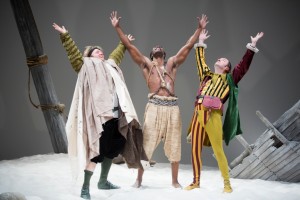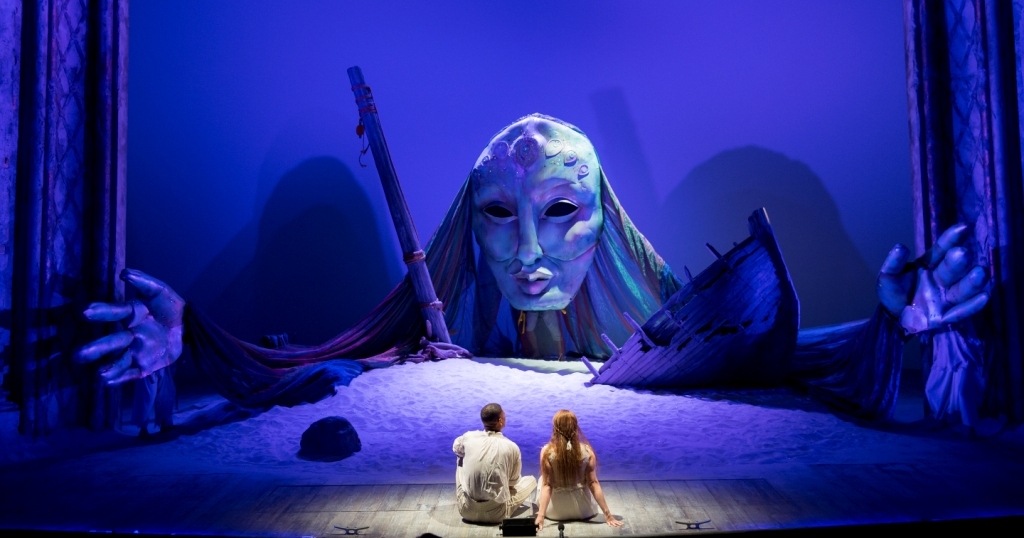The Tempest: Fair winds blow at Washington’s Shakespeare Theatre Company
“Come unto these yellow sands,
And then take hands.
Curtsied when you have and kissed
The wild waves whist,
Foot is featly here and there;
And, sweet sprites, the burden bear.”
Ariel’s song, scene II, Act I
— William Shakespeare, The Tempest
For much of his career as a playwright, William Shakespeare penned the veritable demise of a parade of varlets. It is interesting, then, that in what many scholars consider to be his last solo endeavor, The Tempest – the current production at Washington’s Shakespeare Theatre Company – the Bard opted for rapprochement over the previously prescribed bloodletting.
Directed by former STC Associate Director Ethan McSweeny, The Tempest tells the story of Prospero – the deposed Duke of Milan – and his designs to exact revenge on those responsible for his ruin.
The play opens with a storm which strands a group of ocean-going noblemen on a mysterious Mediterranean island. This tempest was raised by Prospero, who – with the aid of a book of spells – has become a great and powerful magician.

Intuiting that his evil brother Antonio and his cohorts are aboard a passing vessel, Prospero has the ship run aground and then divides the passengers into three different groups. This division of forces alternately leads to intrigue, pathos, wine-soaked humor and romance – all orchestrated by Prospero, who has spent twelve years in exile upon the island.
With Prospero pulling the strings, three separate subplots neatly unfold, leading to a final confrontation between Prospero and his enemies, the “three men of sin”, and to Prospero’s surprising vow: “I’ll break my staff, bury it certain fathoms in the earth, and deeper than did ever plummet sound, I’ll drown my book!” The subplots also lead – inevitably – to a possible union between Propero’s daughter Miranda and Ferdinand – the son of an enemy .
As Prospero says to Ferdinand, “We are such stuff as dreams are made on, and our little life is rounded with a sleep.”
This production, while not as satisfying as director McSweeny’s take on A Mid-Summer Night’s Dream, is nonetheless engaging, thanks largely to its gifted group of actors.
Geraint Wyn Davies leads the cast of talented players as Prospero. Davies’ portrayal is wisely restrained and as a result, quite fascinating. Rachel Mewbron exudes earnest innocence as the enchanting young beauty, Miranda.
Sofia Jean Gomez is a delightful gem as the springy sprite Ariel. At points, her conflicted affection for her master Prospero is almost heartbreaking.
Gregory Linington is particularly menacing as the usurper Antonio. Linington twinned nicely with David Bishins as the equally dangerous Sebastian – King Alonso’s own scheming brother.
C. David Johnson presents a nicely nuanced King Alonso – Antonio’s fellow conspirator. Ted van Griethuysen makes an able Gonzalo – Alonso’s kindly advisor.

As Alonso’s handsome young son, Ferdinand, Avery Glymph seemed a bit unsure at times, but that may be attributed more to his interpretation than to his skill as an actor. His scenes with Prospero are well played, however his moments with Miranda never quite capture the innocent love these two characters are designed to engender.
As two stranded seamen, Liam Craig almost steals the show as Trinculo, while Dave Quay as Stephano grabs drunken revelry by both ends of the barrel. Clifton Duncan as Caliban was most effective in his scenes with this besotted duo.
A solid ensemble fills out a variety of smaller parts.
On the technical side, Christopher Akerlind’s lighting design is effective throughout the show, but especially gripping in the opening storm sequence. Ditto, Nevin Steinberg’s sound design. For five frightening minutes, the entire theatre feels as if it was about to be dashed on the rocks.
The stormy backdrop of the opening scene gives way to a desolate shoreline, which along with opposing villa walls, scenic designer Lee Savage executed beautifully.

Jennifer Moeller’s costume selections are eye-catching and impressive, especially in allowing Prospero to retain his princely bearing while wearing a home-spun tunic.
For Ariel’s assorted airborne sequences, flying director Stu Cox forgoes “invisible” wires – relying instead on the hoisting ability of a sturdy hemp rope. I’m not sure if this is what Shakespeare had in mind (the original folio offered exacting stage directions), but given the nautical nature of The Tempest, this effect works surprisingly well.
Another pleasant surprise is the puppetry of James Ortiz. Paired with the talented players who manipulate the massive puppets, the result is absolutely breathtaking.
Composer Jenny Giering’s music worked mostly well, though vocalist Nancy Anderson seemed somewhat lost as The Voice. Whether this was by design or a reflection of Anderson’s singing, it is hard to say, but the overall effect was uneven at best.
The Tempest may not be Shakespeare’s greatest play, but it is a magical experience and this beautiful production makes it a perfect choice for the holiday season.
* * * * *
The Tempest has just been extended and now runs through Sunday, January 18, 2015, at Sidney Harman Hall (610 F Street NW) in Washington, DC. Discounted parking is available to theatre goers. To purchase tickets or to learn more, patrons can call the box office at 202-547-1122 or by visiting Shakespeare Theatre Company.

Anthony C. Hayes is an actor, author, raconteur, rapscallion and bon vivant. A one-time newsboy for the Evening Sun and professional presence at the Washington Herald, Tony’s poetry, photography, humor, and prose have also been featured in Smile, Hon, You’re in Baltimore!, Destination Maryland, Magic Octopus Magazine, Los Angeles Post-Examiner, Voice of Baltimore, SmartCEO, Alvarez Fiction, and Tales of Blood and Roses. If you notice that his work has been purloined, please let him know. As the Good Book says, “Thou shalt not steal.”

